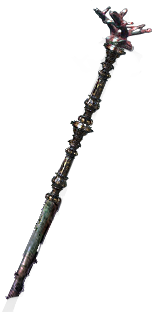Resistance penetration
Penetration is a more powerful version of reduced resistances. In addition to lowering the target's resistance, it also reduces their maximum resistance by the same amount. Equivalently, penetration will always reduce the target's effective resistance by the given amount even if the target is over their resistance cap (after lowered resistance modifiers are applied).
There are various ways to decrease enemy resistance cap:
- Uniques:
 Agnerod EastAgnerod East
Agnerod EastAgnerod East
Imperial StaffStaff
Physical Damage: 57-171
Critical Strike Chance: 7.00%
Attacks per Second: 1.15
Weapon Range: 1.3 metresRequires Level 66, 158 Str, 113 Int+18% Chance to Block Attack Damage while wielding a Staff40% increased Strength Requirement
+(80-120) to Intelligence
(30-50)% increased Lightning Damage
+2 to Level of all Lightning Spell Skill Gems
Damage Penetrates 20% Lightning Resistance
100% increased Duration of Lightning AilmentsOne for each corner of the great Vinktar Square. ,
,  Agnerod NorthAgnerod North
Agnerod NorthAgnerod North
Imperial StaffStaff
Physical Damage: 57-171
Critical Strike Chance: 7.00%
Attacks per Second: 1.15
Weapon Range: 1.3 metresRequires Level 66, 158 Str, 113 Int+18% Chance to Block Attack Damage while wielding a Staff40% increased Strength Requirement
+(80-120) to Intelligence
(30-50)% increased Lightning Damage
+2 to Level of all Lightning Spell Skill Gems
15% chance to Shock
Damage Penetrates 20% Lightning ResistanceOne for each corner of the great Vinktar Square. ,
,  Agnerod SouthAgnerod South
Agnerod SouthAgnerod South
Imperial StaffStaff
Physical Damage: 57-171
Critical Strike Chance: 7.00%
Attacks per Second: 1.15
Weapon Range: 1.3 metresRequires Level 66, 158 Str, 113 Int+18% Chance to Block Attack Damage while wielding a Staff40% increased Strength Requirement
+(80-120) to Intelligence
(30-50)% increased Lightning Damage
+2 to Level of all Lightning Spell Skill Gems
+5% to maximum Lightning Resistance
Damage Penetrates 20% Lightning ResistanceOne for each corner of the great Vinktar Square.
- Gems: Module Error: No skills found with q_where = skill.active_skill_name="Fire Penetration", Module Error: No skills found with q_where = skill.active_skill_name="Cold Penetration", Module Error: No skills found with q_where = skill.active_skill_name="Lightning Penetration"
- Certain passive skills
Examples
Consider a player using a skill with Penetrates 50% Fire Resistance dealing 100 fire damage to an enemy:
- If the enemy has +0% Fire resistance
- The enemy's resistance will be treated at 50 lower than it is, which in this case will result in an effective -50% fire resistance. The enemy will take 150 fire damage.
- If the enemy has +25% Fire resistance
- This will result in an effective -25% fire resistance. The enemy will take 125 fire damage.
- The enemy has +150% Fire resistance, but is capped at their maximum fire resistance of 75%
- This will result in an effective 25% fire resistance. The enemy will take 75 fire damage.
- The enemy has +150% Fire resistance, but is capped at their maximum fire resistance of 75%. The enemy is cursed with
 Flammability before being attacked, which causes them to lose 30% Fire Resistance.
Flammability before being attacked, which causes them to lose 30% Fire Resistance.
- The enemy first loses 30% resistance, bringing them down to +120% fire resistance. They are still well above their maximum, and their resistance value remains at 75%. The 50% penetration then results in an effective 25% fire resistance. The enemy will take 75 fire damage.
- The enemy has +10% Fire resistance. The enemy is cursed with
 Flammability before being attacked, which causes them to lose 30% Fire Resistance.
Flammability before being attacked, which causes them to lose 30% Fire Resistance.
- The enemy first loses 30% resistance, bringing them down to -20% fire resistance. The 50% penetration then results in an effective -70% fire resistance. The enemy will take 170 fire damage.